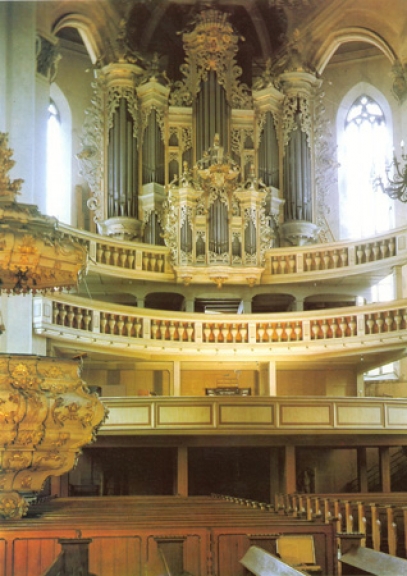


Naumburg, Wenzelskirche

Zacharias Thayßner 1695-1705 (case by Johann Goericke 1697/99, colouring 1766); new organ within the old case by Zacharias Hildebrandt 1743-1746 including some older pipes.
State of preservation: Several changes in specification and alteration of pitch during the 19th century, in 1932 instalment of an electro-pneumatic action while preserving the old action. In 1993-2000 restoration by Hermann
Eule.
Thayßner's organ had been described as "short-breathed" and lacking any "gravity." Statements by Zacharias Hildebrandt, Gottfried Heinrich Trost, Christian Ernst Friederici and Johann Sebastian Bach (lost) initiated a new organ built by Zacharias Hildebrandt. Johann Sebastian Bach might have participated in the specification; in september 1746 he, together with Gottfried Silbermann, examined the completed organ and state Hildebrandt having „überhaupt alles und jedes mit gehörigem Fleiße verfertiget. (done each and everything with appropriate diligence).“ In 1748 Bach's pupil and son in law Johann Christoph Altnikol became organist at St. Wenzel.
Building the new organ into the old case was not easy for sure. Hildebrandt made it one of the largest organs in the region. The close connection to Bach aroused a lot of attention for this instrument which appeared for some a model "Bach organ" presumably matching his wishes and intentions and particularly suited for the interpretation of his organ works.
Musikbeispiel:
J.S. Bach : Sonata No 3 in d BWV 527, Andante
played by Gerhard Weinberger
Specification (1743)
III+P/53
HW:
Principal 16’ (engl. tin)
Quintathen 16’ (metal)
Octav 8’ (tin)
Spill oder Spitz flöt 8’ (metal)
Gedackt 8’ (metal)
Octav 4’ (tin)
Spill oder Spitz flött 4’ (metal)
Quinta 2 2/3’ (tin)
Sexquint altra 2 2/3’+1 3/5’ 2f. (tin)
Octav 2’ (tin)
Weit Pfeiffe 2’ (tin)
Cornett [4' 4f. (tin, from c1)
Mixtur 8f. (tin)
Bombart 16’ (C-H wood, from c0 metal)
Trompet 8’ (tin)
OW:
Burdun 16’ (C-H wood, from c0 metal)
Principal 8’ (tin)
Hollflött 8’ (metal)
Unda maris 8’ (from a0; beyond contract)
Praestant 4’ (tin)
Gemshorn 4’ (metal)
Quinta 2 2/3’ (tin)
Octav 2’ (tin)
Waldflött 2’ (metal)
Tertia 1 3/5’ (tin)
Quinta 1 1/3’ (tin)
Süfflött 1’ (tin)
Scharff 5f. (tin)
Vox humana 8’ (tin)
RP:
Principal 8’
Violdigamba 8’
Rohrflött 8’
Quintathen 8’
Praestant 4’
Fugarra 4’
Rohrflött 4’
Naßat 2 2/3’
Octav 2’
Rausch Pfeiffe 2f.
Cymbel 5f.
Fagott 16’
Tremulant
P:
Prinzipal 16’
Violon 16’
Subbaß 16’
Oktav 8’
Violon 8’
Octav 4’
Nachthorn 2’
Mixtur 7f.
Posaune 32’
Posaune 16’
Trompett 8’
Clarin 4’
Couplers (HW/P; RP/HW; OW/HW), 4 stop knobs, Zimbelstern
© Greifenberger Institut für Musikinstrumentenkunde | info@greifenberger-institut.de



